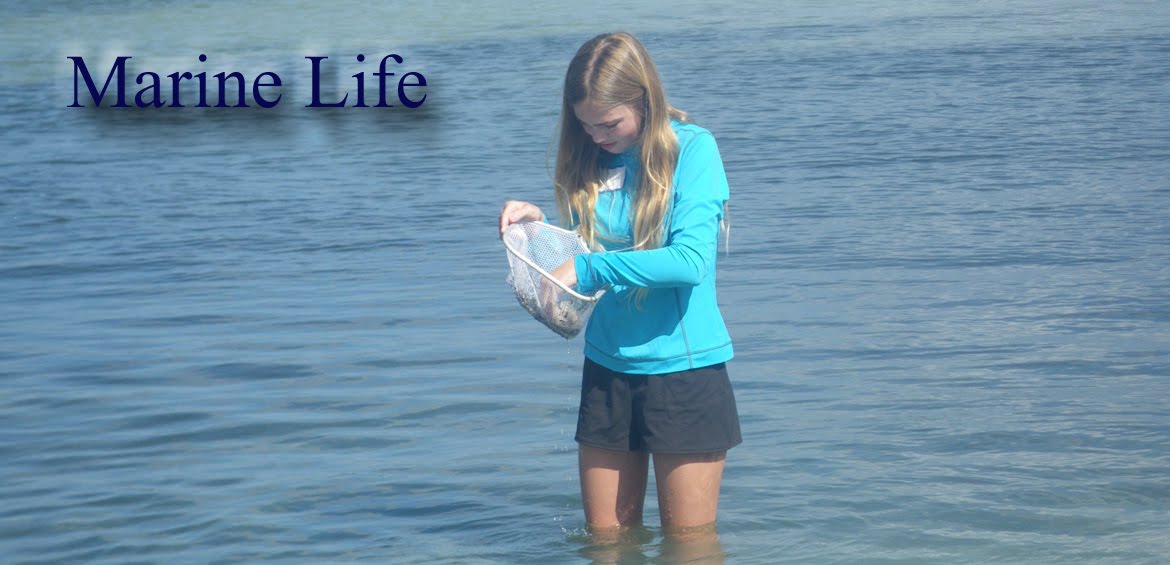Sunday, October 5, 2014
Sunray Venus Clam
The sunray venus clam (Macrocallista nimbus), is given its common name for the patterns on its shell. They are often found off of Florida's coast. Their colours vary from dark brown, to light tan on the outside, while the inside of their shells are white. They can get to be six inches long.
Thursday, August 28, 2014
Lesser Butterfly Ray

The lesser butterfly ray (Gymnura micrura) also sometimes known as smooth butterfly rays. They have no venomous barb. Some of their prey includes fish, crustaceans, and bivalves. Their dorsal side varies in colour from grey, to brown, to almost greenish. They prefer sandy environments and are often found in estuaries, bays, and off beaches.
Thursday, July 3, 2014
Pinfish
 |
| Juvenile Pinfish near Jetty |
Wednesday, March 19, 2014
Turkey Wing
The turkey wing clams (Arca zebra), are also called zebra arks because their reddish brown stripes resemble zebra stripes. Turkey wings live attached to rocks. They have a gap at either side of their shells which allows them to attach themselves to the rocks with their byssal threads. They can grow up to be four inches across. Their range is from North Carolina, down to the West Indies.
Tuesday, February 25, 2014
Common Snook
.JPG) |
| Common snook off Lido |
.JPG) |
| Common snook off Lido |
.JPG) |
| Common snook off Lido |
other snooks. The large scaled fat snook is a more recently discovered species. Snook are usually thought of as a game fish, but there is so much more to snook than just being on the end of a line. Mote Marine Laboratory is doing a lot of research on the common snook, and are raising snook to restore native populations.
Tuesday, January 28, 2014
A Sad Trip To Lido
 |
| Brown Pelican |
 |
| Green Sea Turtle |
Last week, my mom and I walked on the beach after I was done volunteering at Save Our Seabirds. What we saw was very upsetting. First we found a dead brown pelican. Someone had put a cigar into its bill. I removed the cigar from its bill and adding it to the trash I was removing from the beach. We continued walking and in the distance, we saw some people taking something out of the water. We were pretty far away so I could not tell what it was right away, it looked a little like a sea turtle. I walked over and we saw that they pulled a dead sea turtle out of the water and were reporting it to Mote. It had several fibropapilloma tumors on it which could have caused its death. Another sad thing that was on the beach was the amount of trash that lined the shore. I must have picked up a hundred plastic bottle caps plus lots of other trash like an old battery. The reason why I am starting my beach clean-up project is to remove the trash on the beach before it gets eaten by animals and pollutes the ocean. I also hope to educate people about the threats that debris has on not just our coastline, but on the ocean and the animals that live in it.
 |
| Trash That We Picked Up |
Thursday, January 23, 2014
Sarasota Ocean Preservers
I recently got a grant to start my own beach cleanup. It is called Sarasota Ocean Preservers. I will probably start the program in March. Right now, I am working on a logo, and I am going to work on a website shortly. My logo will either have a devil ray, a green sea turtle, or a spotted eagle ray.
Update: I have had my cleanup program for over a year and have expanded to snorkel cleanups and I plan to start kayak cleanups as well. http://www.oceanpreservers.org/ is the address to the main website.
Update: I have had my cleanup program for over a year and have expanded to snorkel cleanups and I plan to start kayak cleanups as well. http://www.oceanpreservers.org/ is the address to the main website.
Subscribe to:
Posts (Atom)




